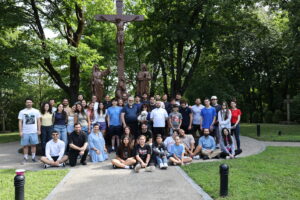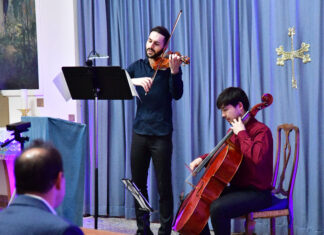By Aram Arkun
Mirror-Spectator Staff
WATERTOWN — Ani Babaian-Khachikian gave an illustrated lecture on the Armenians in Iran at the St. James Armenian Church’s Men’s Club on March 2, with a specific focus on the New Julfa Armenian community. Men’s Club Chairman Dick Janjigian served as the master of ceremonies. Nearly 100 people were present at this talk.
Babaian-Khachikian started by expounding on the ancient ties between Armenia and Iran. For centuries Iran ruled over Armenia, and even in modern times parts of historical Armenia lie within Iran’s borders, including areas to the west of Lake Urmia. Armenian conversion to Christianity, and Iranian conversion to Islam, increased tensions between the two peoples. The famous Battle of Avarayr of 451 AD, for example, took place on territory today located in Iran.
In the 17th century, Shah Abbas I, king of Iran, deported several hundred thousand Armenians from Ottoman-controlled historical Armenia into new locations in Iran as part of a scorched earth policy against his Ottoman enemies. This led to new Armenian settlements outside of historic Armenian territory, especially in Isfahan. Further new communities of Armenians were created in the 1930s due to the expansion of the Iranian oil industry in the southwest of the country, though during the recent Iran-Iraq war (1980-88) most of them were depopulated.
Babaian-Khachikian turned her attention to the Armenians of New Julfa (Nor Jugha in Armenian), who were deported in 1605 from the famous medieval trading center of Jugha on the Araks River in the heart of historical Armenia. They were settled in a new suburb of Isfahan named after their old city. One of the many bridges connecting New Julfa to Isfahan was built by the Armenian general Allahverdi Khan. It has 33 arches, Babaian-Khachikian said, which are said by some to symbolize the 33 years of Christ on earth.
Many of the streets of New Julfa bear Armenian names even today. The oldest one, Nazar Street, is named after the famous merchant Khoja Nazar. More recently, the city hall of Isfahan replaced many non-Armenian street names with the names of Armenian soldiers for Iran killed in the Iran-Iraq war.
Many of the homes of the wealthy Armenian merchants of New Julfa had beautiful interiors. While most have been destroyed, the state Iranian Cultural Heritage Organization added the few that are still standing to its architectural heritage list. They are being used by the Isfahan Art University and are still known by their original owners’ names.
Babaian-Khachikian pointed out that education was important for the New Julfans even in the 17th century. At that time the Surb Amenaprkich Monastery was a center not only of religious education but also provided practical lessons necessary for the Armenian mercantile class.
Armenian girls were taught by nuns at the St. Katarine Armenian Apostolic Church until the founding of the first girls’ school in 1857. In 1880, the Armenian central school was founded for the needs of all students.
Today, the Armenian schools go from kindergarten to high school, following the official state curriculum. Graduates get both state diplomas and Armenian ones. Furthermore, in the 1960s the University of Isfahan established a Center for Armenian Studies. Today, there are only Persian students studying at this center, though some of the teachers are still Armenians.
Until the beginning of the 20th century, Armenians continued to wear their traditional costumes from Old Julfa. Today in public Armenian women must wear a headscarf, but are free to dress as they please at home.
New Julfa had 24 Armenian Apostolic churches in the late 19th century, and 13 are still operational today. Each of their domes has the form of an Islamic mosque’s dome, but the dome of the mosque is covered with ceramic tiles, while the Armenian dome uses brick and has a cross on top. During the 18th century, bell towers with conical domes were added to the churches.
Surp Amenaprkich Monastery (1664), and the churches of the Holy Mother of God (1613), Holy Bethlehem (1628), and St. Stepannos (1666) are decorated with extensive mural paintings. The clerics of New Julfa produced a unique style of manuscript illustration.
Surp Amenaprkich Monastery includes a cathedral, museum, offices, chancellery, bell tower, clock tower, an Armenian Genocide monument, and a library with the second largest collection of manuscripts in the diaspora. The first Armenian printing press in Iran was established in this monastery complex in 1636, 192 years before the printing of the first Persian-language book in Iran. The monastery’s publishing house is still active today. The church still commemorates all the important Armenian church holidays and many Iranians come to place flowers before the Armenian Genocide monument every April.
Ani Babaian-Khachikian participated in restoration works of the murals of the gavit or narthex of the cathedral of the monastery thanks to the support of Iran’s Cultural Heritage Organization. It is thanks to the Islamic Republic of Iran that three Armenian churches on Iranian territory have been placed on UNESCO’s World Heritage List, and now efforts are being made to add the Surp Amenaprkich Monastery to the same list.
Babaian-Khachikian, a native of Isfahan, has a bachelor of fine arts degree from Islamic Azad University and a Master of Fine Arts degree from Alzahra University in Tehran. Her thesis at Alzahra was entitled “Mutual Influences: New Julfa and Isfahan Mural Paintings of the 17th Century.” She has authored numerous articles on Armenian and Persian art and has taught art courses in Iran. After marrying Saro Khachikian from Peabody she moved in 2010 to Massachusetts, where in 2013 she joined the National Association of Armenian Studies and Research as a cataloguer of the Mardigian Library. Aside from her scholarly work, she is also a fine arts painter who frequently participates in solo and group exhibitions.
Babaian-Khachikian Puts Focus on Armenians of Iran
Top 5 Articles
- Trending
- Most Viewed
- Most Commented
- Thinking in Dark Times: The End of Tradition and the Crisis of Holocaust and Genocide Studies
- Holy Trinity Armenian Apostolic Church ‘Honoring Our Nonagenarian Members’
- Houshamadyan: Cuisine and Fried Omelets from Diyarbekir
- Recipe Corner: Elsie S. Donigian’s Potato Kufteh
- Haik Kazazyan Wins 2025 Classic Violin Olympus International Competition
- Why I Am Grateful to Erdogan, the Dictator of Turkey
- A Political Whirlwind Engulfs Nagorno Karabakh
- Libya’s Interim Government Recognizes the Armenian Genocide Once Again
- Robert Bedrosian Marries High Tech With Ancient Armenian Manuscripts
- Aleppo Aid through St. Kevork Armenian Apostolic Church of Houston







